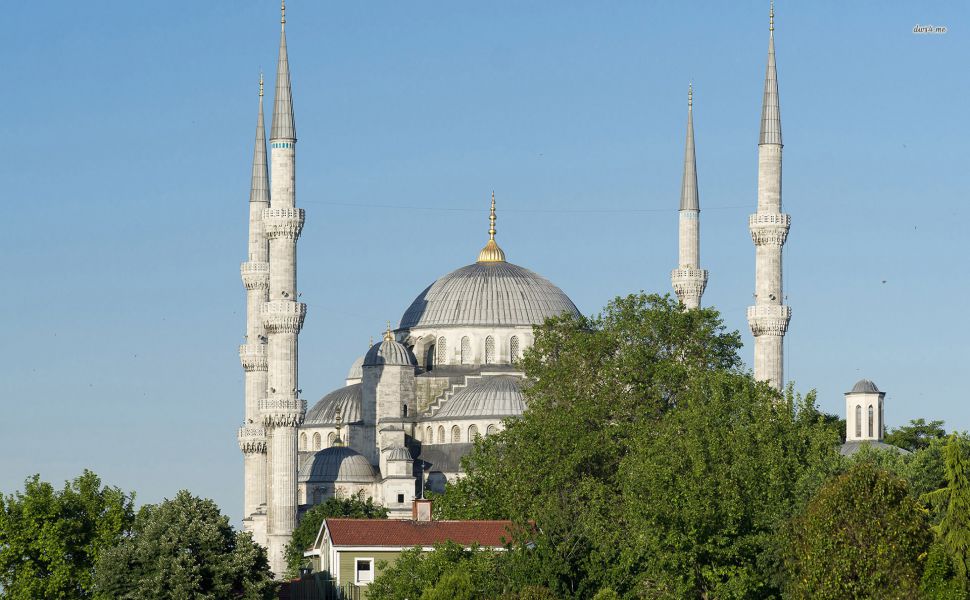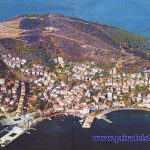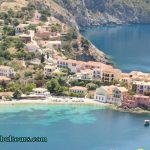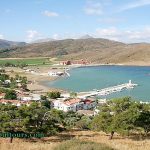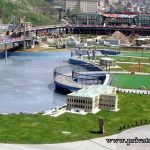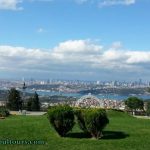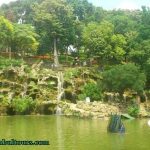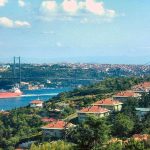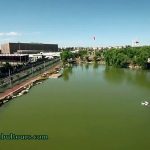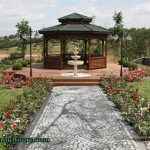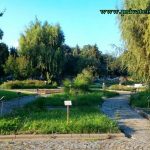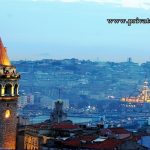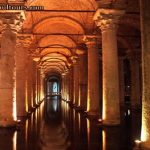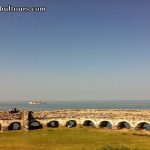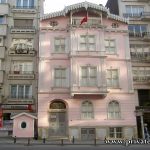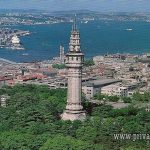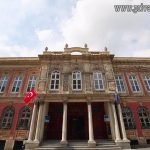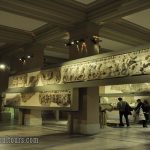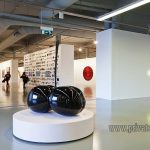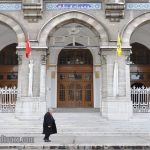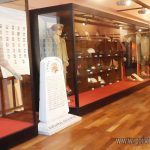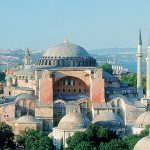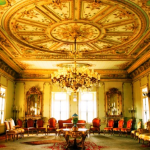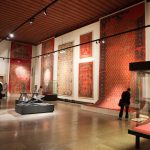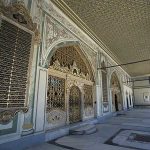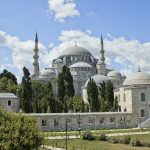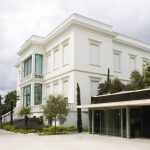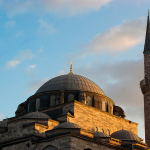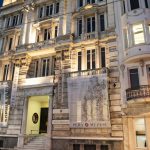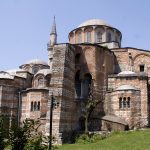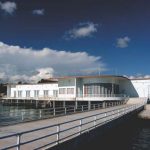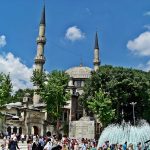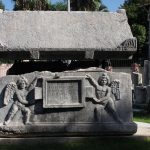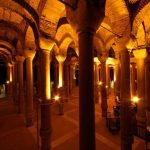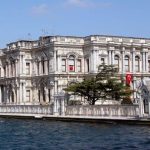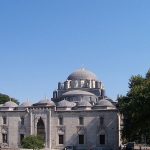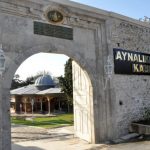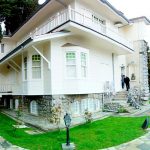Architect Sedefkar Mehmet Ağa formed the plan of the community by taking into consideration the classical architectural style of Mimar Sinan. The mosque was located in the center. Because it was located directly opposite Hagia Sophia, it was at least as magnificent as it was. Especially with their interior decorations, they have a dazzling appearance with their tiles. The main space is 64 × 72 m, the height is 43 m, and the dome is 33.6 m. The main dome occupies four grooves with a diameter of 5 meters and half dome carried by the pointed arches. There are four half domes on the corners. The walls of the building consist of 260 windows in five rows. The walls are covered with blue-white, turquoise, green Iznik tiles in weight. Because of this unique color richness, strangers wear the name Blue Mosque, which means “Blue Mosque”.
It is decorated with marble mimbar and embroidered marble mihrab and rich pearl ornaments embroidered on the left corner. The inner part of the mihrab is covered with beautiful flower motifs. Mimber must be gilded, embossed and geometric. It is a unique work with the door of Hunkar mahfil and mother of pearl. The inner courtyard of the glass covered with marble is entered from three doors with stairs. The last congregation with its place is an inner courtyard with 26 columns and 30 small dome covers. In the center of the courtyard there is a thin-walled fountain with six marble columns. The fountain’s arches are decorated with tulip and carnation motifs.
Facing the Hagia Sophia, there is a madrasa. There are rooms surrounded by porticos with porticos. The tomb next to Ahmet’s medress was made after the end of the community of buildings. The turban inlaid door of the turban is a work of art. Other than Ahmet I., children in Türü II. Osman, IV. Murat and his wife Mahpeyker Kösem Sultan have a total of 36 sarcophagus. At the top of the old Byzantine Grand Palace in front of the altar of the altar, there is the Mosaic Museum, where Arasta, immediately adjacent to the Byzantine period, exhibits original mosaics. At the western end of the hippodrome are imaret, tabhane and darüşşifa. One of the original structures of the glass is the hünkar kasri which has an independent appearance. By the 17th century it was used as an independent part of the glass.
One of the most important features of the Sultanahmet Mosque is the formation of 6 minarets. The minarets were used as items connecting the inner courtyard with the main building. The two minarets on the outer corners of the courtyard are two sheriffs, four minarets on the four corners of the glass, three cherries.
Actually Sultan Ahmet Mosque is one of the biggest building complexes in Istanbul with its complex. This complex consists of a mosque, medreseler, künkar kasrı, arasta, shops, hamam, fountain, sebiler, tomb, darüşşifa, sıbyan mektebi, imarethane and rented rooms. Some of these structures have not reached the present day.
Architectural
The design of the Sultanahmet mosque marks the summit of 200 years of synthesis of Ottoman mosque architecture and Byzantine church architecture. In addition to having some Byzantine breezes from neighboring Hagia Sophia, traditional Islamic architecture is also seen as the last great mosque of the classical period. Caminin’s architecture has succeeded in reflecting the ideas of great master Mimar Sedefkar Mehmet Aga’s “size in size, grandeur and splendor”.
Outside Structure
The appearance of the Sultan Ahmet Mosque from the top of Hagia Sophia. Apart from the addition of small towers above the cornered domes, the front of the large front courtyard was made in the same style as the Suleymaniye Mosque. The courtyard is nearly as wide as the glass itself and is turned into an unbroken arch. There are ablutions on both sides. The size of the large hexagonal fountain courtyard in the middle is small when considered. The narrow monumental passage leading to the courtyard stands architecturally different from the arches. The half-dome is crowned with a smaller protruding dome and has a fine stalactite structure.
Internal structure
The interior of the mosque is decorated with more than 20 tiles produced from 50 different tulip designs in İznik on every level. The Chinese in the lower levels are traditional, while the designs of the Chinese in the gallery are splendid and magnificent with flowers, fruits and servants. More than 20 pieces of tiles have been produced in İznik under the direction of Kasap Hacı and Cappadocian Baris Efendi. Although the amount to be paid per tile is regulated by the order of the Sultan, the tile price has increased over time, and the quality of the tiles used has decreased over time. Their color is faded and their polishes are faded. The Chinese on the rear balcony wall are the tiles recycled from the harem of the Topkapi Palace, which was damaged in the fire of 1574.
The unknowns of Sultan Ahmet Mosque:
The Sultanahmet Mosque built by Sultan Ahmet in 1616 against architect Sedefkar Mehmet Aga in front of Hagia Sophia is among the most popular tourist attractions in the city. The foundations of the mosque were thrown on December 31, 401 years ago.
The Sultanahmet Mosque, which was built by Ottoman sultans and family and which means “Sultan mosques”, is called “Blue Mosque” by the Europeans because it is decorated with Iznik tiles.
Located in the historical peninsula of Istanbul, Sultanahmet Mosque is known as the greatest and most important work of classical architecture after Mimar Sinan.
While the construction of the glass was completed in 1616, the other buildings of the mausoleum, built until 1620, were placed in a disorganized arrangement.
Sedefkar Mehmet Ağa, a student of the Sultanahmet Mosque and the Mimar Sinan in the mosque, made a major breakthrough in architecture in parallel with the political progress of the state, using untested details of classical tradition.
The buildings were grouped into religious, educational buildings and social facilities according to their functions around the mosque and hunkar kas which dominate the whole area and are located in the outer courtyard.
Decorated with Iznik tiles, it stands out as the most important aspect of architecture in terms of architecture and art. The use of traditional plant motifs in yellow and blue tones, embellished with blue, green and white colored Iznik tiles and decorated with Chinese tiles, makes it more than just a place of worship.
The Sultanahmet Mosque also features the fact that Turkey is the only one with six minarets.
The sultan of the period I wanted to have minarets under gold, but the gold of the gold that would be used in the plunge exceeded the sultan’s budget, and the architect Sedefkar Mehmet Aga of the mosque had misunderstood this command and made the word “gold” “six” Built the mosque with 6 minarets. ”
The part of the worship place for a total of 260 window-lit windows is 64 x 72 meters. The diameter of the central dome at 43 meters in height is 23.5 meters.
At the western entrance of the courtyard there is a heavy cord from the dam. This cord required the court to bow to the head of the sultan entering the courtyard. This was accepted as a symbolic act to show that even the sultan would have to regulate himself when he entered the mosque.
According to the information received from the General Directorate of Foundations, the mosque, which is registered to the Sultan Ahmed Evvel Foundation, constitutes the main structure of a large mosque.
The plan is similar to the Şehzade Mosque, and the central dome supports four half domes in four directions. It is covered with rich Iznik tiles inside the rectangle planned work close to the square.
Professor of art history who informs AA correspondent about Sultanahmet Mosque. Dr. Semavi Eyice said that the Sultanahmet Mosque, a work of the Albanian-born Sedefkar Mehmet Aga, who grew up after Mimar Sinan and continued his style, was a very rich architecture.
Some parts of the glass built in the form of folding voicing over time, Prof. voicing. Dr. Eyice said, “The Sultanahmet Mosque has 6 minarets. This property does not exist in another mosque, “he said.
Prof. Dr. Eyice recorded that the mausoleum was the Hospital of the Darussalian, and that one of the lectures was destroyed, while the other stopped.
After the Sultanahmet Mosque, “Arasta” was used and it was restored after years of not being used for the fire, Prof. explains that the veins inside the entrance and exit of the bazaar are covered with china, but they are broken by some of them. Dr. Eyice said: “Every minaren’s body is adorned in a different way. Except for the Prince Mosque, we have minarets. There are different ornaments on the minarets in Sultanahmet Mosque. One has servi figurines on it. The glass of bronze has very nice doors. It is also called “Blue Mosque” because of the Chinese inside. The Blue Mosque is over-bright. It is the lowering of the colored glass in the wreck in a cause revolution. The building had a very bad restoration in the 19th century. The restoration was done by the Greeks. The partition made for the rest of the ladies to be rested before being lost is called Kasr-ı Hümayun. The Sultanahmet Mosque also has this section. The first excavation in the construction of the 1st Sultan Ahmet’s mosque, which was a childhood sultan and died at a young age, is still stored in Topkapı Palace today. ”
The mosque imam, Emrullah Hatipoglu, said that Sultanahmet, which is about 400 years old, is one of the most widespread glass of Istanbul, the most widespread of the world, and one of the first to come to mind when considering the city’s cultural and natural beings.
Hatipoğlu, who stated that the minaret of the glass, its crown, minarets and the secrets of the mosque are special, emphasized that the mihrab had a different meaning.

